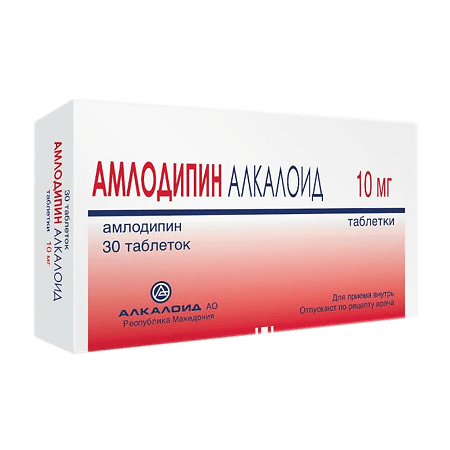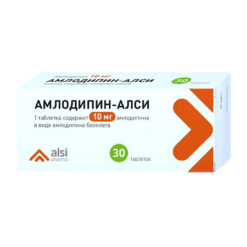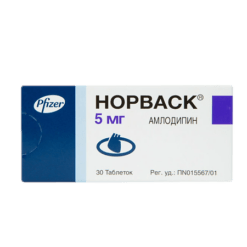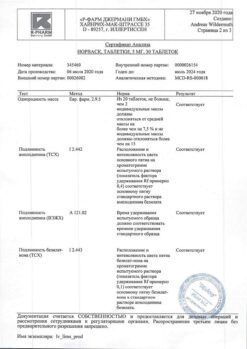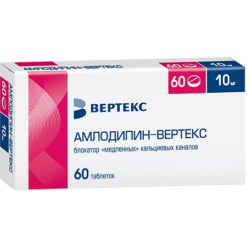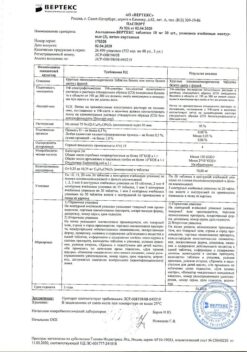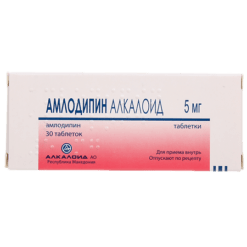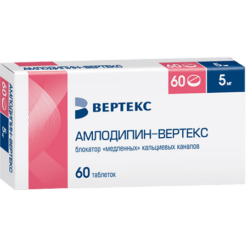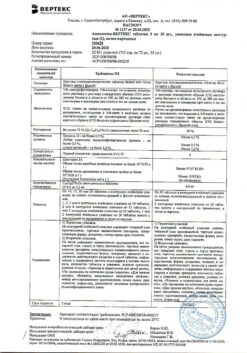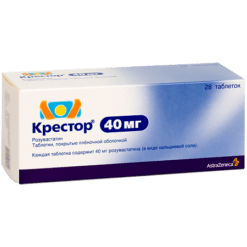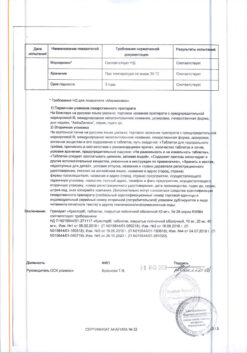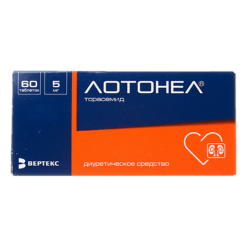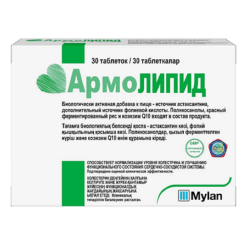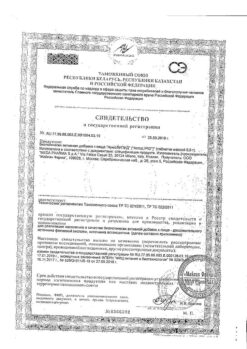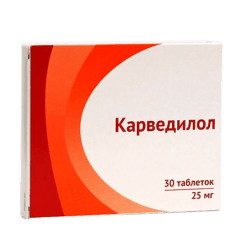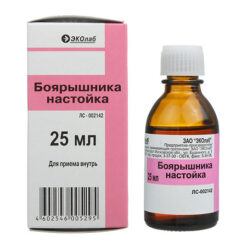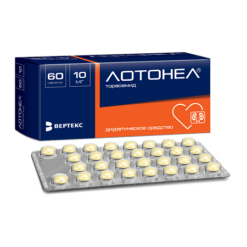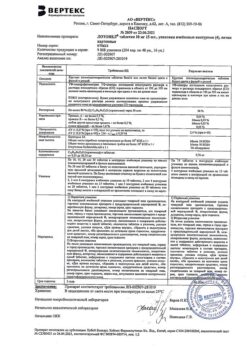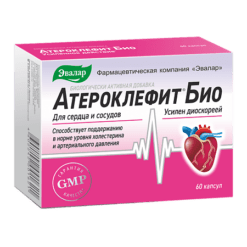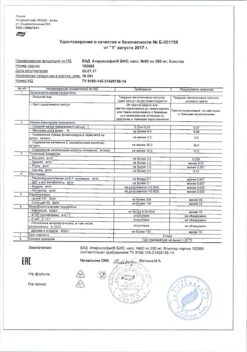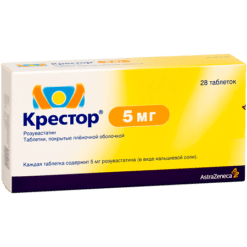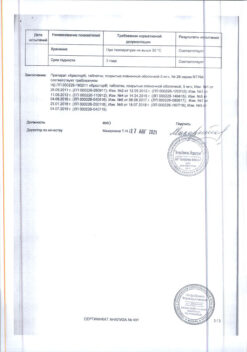No products in the cart.
Amlodipine Alkaloid, tablets 10 mg 30 pcs
€5.01 €4.45
Description
A dihydropyridine derivative. It has antihypertensive and antianginal action. It blocks the entry of calcium ions through cell membranes into myocardial and vascular smooth muscle cells.
Antianginal action is due to dilation of coronary and peripheral arteries and arterioles: in angina reduces the severity of myocardial ischemia; by dilating peripheral arterioles, it reduces myocardial hypertension, reduces postload on the heart, reduces myocardial oxygen demand. By dilating the main coronary arteries and arterioles in the unchanged and ischemic areas of the myocardium increases the flow of oxygen to the myocardium (especially in vasospastic angina); prevents the development of coronary artery constriction (including that caused by smoking). In patients with angina a single daily dose increases exercise tolerance, slows down the development of angina and “coronary depression” segment S-T, reduces the frequency of angina attacks and nitroglycerin consumption.
It has a long-term dose-dependent hypotensive effect. The hypotensive effect is due to direct vasodilating effect on vascular smooth muscle. In arterial hypertension a single dose provides clinically significant BP reduction for 24 hours (in “lying” and “standing” positions). It does not cause a sharp decrease in BP, decreases exercise tolerance and LV ejection fraction. It reduces the degree of LV myocardial hypertrophy, has anti-atherosclerotic and cardioprotective effect in CHD. It does not increase the risk of death in patients suffering from CHF (III-IV class according to NYHA), against the background of digoxin, diuretics and ACE inhibitors therapy.
It has no effect on myocardial contractility and conduction, does not cause reflex increase of HR, inhibits platelet aggregation, increases glomerular filtration rate, has weak natriuretic effect. In diabetic nephropathy it does not increase the severity of microalbuminuria. It does not have adverse effects on metabolism and plasma lipids and is suitable for treatment of patients with concomitant bronchial asthma and diabetes.
Pharmacokinetics:
Absorption – slow, does not depend on food intake, is about 90%, bioavailability – 60-65%. The tCmax when taken orally is 6-12 hours. Css is formed in 7-8 days after continuous use. The volume of distribution is 21 l/kg. Binding with plasma proteins is 90-97%. It penetrates through the BBB.
Intensively (90%) metabolized in the liver to form inactive metabolites, has “first pass” effect through the liver. T1/2 averaged 35 hours. Total clearance is 500 ml/min.
T1/2 in patients with arterial hypertension-48 hours in elderly patients is increased up to 65 hours, in hepatic insufficiency – up to 60 hours, similar parameters of T1/2 increase are observed in severe CHF, in renal impairment – unchanged. In hemodialysis it is not eliminated.
Excreted by the kidneys-60% as metabolites, 10% unchanged, with the bile and intestine-20-25% as metabolites, as well as with breast milk.
Indications
Indications
Arterial hypertension, exertional angina, vasospastic angina.
Pharmacological effect
Pharmacological effect
Dihydropyridine derivative. It has antihypertensive and antianginal effects. Blocks the entry of calcium ions through cell membranes into the smooth muscle cells of the myocardium and blood vessels.
The antianginal effect is due to the expansion of the coronary and peripheral arteries and arterioles: in case of angina pectoris, it reduces the severity of myocardial ischemia; by expanding peripheral arterioles, it reduces peripheral vascular resistance, reduces afterload on the heart, and reduces myocardial oxygen demand. By expanding the main coronary arteries and arterioles in unchanged and ischemic areas of the myocardium, it increases the supply of oxygen to the myocardium (especially with vasospastic angina); prevents the development of constriction of the coronary arteries (including those caused by smoking). In patients with angina pectoris, a single daily dose increases exercise tolerance, slows down the development of angina and “ischemic depression” of the S-T segment, reduces the frequency of angina attacks and nitroglycerin consumption.
It has a long-term dose-dependent hypotensive effect. The hypotensive effect is due to a direct vasodilating effect on vascular smooth muscle. For arterial hypertension, a single dose provides a clinically significant reduction in blood pressure over 24 hours (in the patient’s “lying” and “standing” position). Does not cause a sharp decrease in blood pressure, a decrease in exercise tolerance, or LV ejection fraction. Reduces the degree of LV myocardial hypertrophy, has an antiatherosclerotic and cardioprotective effect in ischemic heart disease. Does not increase the risk of death in patients suffering from CHF (NYHA class III-IV) during therapy with digoxin, diuretics and ACE inhibitors.
It has no effect on myocardial contractility and conductivity, does not cause a reflex increase in heart rate, inhibits platelet aggregation, increases the glomerular filtration rate, and has a weak natriuretic effect. In diabetic nephropathy, it does not increase the severity of microalbuminuria. It has no adverse effects on metabolism and plasma lipids, and is suitable for the treatment of patients with concomitant bronchial asthma and diabetes mellitus.
Pharmacokinetics:
Absorption is slow, does not depend on food intake, is about 90%, bioavailability is 60-65%. Tmax when taken orally is 6-12 hours. With continuous use, Css is created in 7-8 days. Volume of distribution – 21 l/kg. Communication with plasma proteins -90-97%. Penetrates through the BBB.
Intensively (90%) is metabolized in the liver with the formation of inactive metabolites, has a “first pass” effect through the liver. T1/2 on average -35 hours. Total clearance – 500 ml/min.
T1/2 in patients with arterial hypertension – 48 hours in elderly patients increases to 65 hours, with liver failure – up to 60 hours, similar parameters for the increase in T1/2 are observed in severe CHF, in case of impaired renal function – does not change. It is not removed during hemodialysis.
Excreted by the kidneys – 60% in the form of metabolites, 10% unchanged; with bile and through the intestines – 20-25% in the form of metabolites, as well as with breast milk.
Special instructions
Special instructions
During treatment, it is necessary to control your body weight and observe a dentist (to prevent pain, bleeding and gum hyperplasia).
Amlodipine does not affect plasma concentrations of K+, glucose, triglycerides, total cholesterol, LDL, uric acid, creatinine and urea nitrogen.
Despite the absence of withdrawal syndrome in BMCC, a gradual dose reduction is recommended before stopping treatment.
Active ingredient
Active ingredient
Amlodipine
Composition
Composition
One tablet contains amlodipine (as amlodipine besylate) 10,000 -13,869 mg.
Excipients:
lactose monohydrate,
magnesium stearate,
microcrystalline cellulose.
Contraindications
Contraindications
Hypersensitivity to the drug and other dihydropyridine derivatives, severe arterial hypotension, collapse, unstable angina (with the exception of Prinzmetal’s angina), pregnancy, lactation.
With caution:
Arterial hypotension, aortic stenosis, chronic heart failure, liver failure, acute myocardial infarction (and within 1 month after), hypertrophic obstructive cardiomyopathy (HOCM), sick sinus syndrome (SSNS) and mitral stenosis, age up to 18 years (efficacy and safety of use have not been established), elderly age.
Side Effects
Side Effects
From the nervous system: headache, dizziness, excessive fatigue, drowsiness, mood changes, convulsions; rarely – loss of consciousness, hypoesthesia, paresthesia, tremor, asthenia, malaise, insomnia, nervousness, depression, unusual dreams, anxiety; very rarely – ataxia, apathy, agitation, amnesia.
From the digestive system: nausea, abdominal pain; hyperbilirubinemia, jaundice, increased activity of “liver” transaminases; rarely – dry mouth, vomiting, anorexia, constipation or diarrhea, dyspepsia, flatulence, gum hyperplasia; very rarely – gastritis, pancreatitis.
From the cardiovascular system: palpitations, swelling of the ankles and feet, shortness of breath, flushing of the face, rarely – rhythm disturbances (bradycardia, ventricular tachycardia, atrial flutter), chest pain, marked decrease in blood pressure, orthostatic hypotension; very rarely – development or worsening of heart failure, extrasystole, vasculitis, migraine.
From the genitourinary system: rarely – pollakiuria, painful urge to urinate, nocturia, sexual dysfunction (including decreased potency); very rarely – dysuria, polyuria.
From the musculoskeletal system: rarely – arthralgia, arthrosis, myalgia (with long-term use); very rarely – myasthenia gravis.
From the skin: very rarely – xeroderma, alopecia, dermatitis, purpura. Allergic reactions: skin itching, rash (including erythematous, maculopapular rash, urticaria).
Other: rarely – blurred vision, conjunctivitis, diplopia, eye pain, impaired accommodation, xerophthalmia, ringing in the ears, gynecomastia, back pain, feeling of heat and “flushing” of blood to the face, chills, weight gain, dyspnea, nosebleeds, increased sweating, thirst; very rarely – cold sticky sweat, cough, rhinitis, parosmia, perversion of taste.
Interaction
Interaction
Inhibitors of microsomal oxidation increase the concentration of amlodipine in plasma, increasing the risk of side effects, and inducers of microsomal liver enzymes reduce it.
The hypotensive effect is weakened by NSAIDs, especially indomethacin (Na+ retention and blockade of Pg synthesis by the kidneys), alpha-agonists, estrogens (Na+ retention), sympathomimetics.
Thiazide and loop diuretics, beta-blockers, verapamil, ACE inhibitors and nitrates enhance the antianginal and hypotensive effects.
Amiodarone, quinidine, alpha1-blockers, antipsychotic drugs (neuroleptics) and BMCC may enhance the hypotensive effect.
Does not affect the pharmacokinetic parameters of digoxin and warfarin. Cimetidine does not affect the pharmacokinetics of amlodipine.
When used together with Li+ drugs, it is possible to increase the manifestations of their neurotoxicity (nausea, vomiting, diarrhea, ataxia, tremor, tinnitus).
Ca2+ preparations can reduce the effect of BMCC.
Procainomide, quinidine, and other drugs that cause QT prolongation enhance the negative inotropic effect and may increase the risk of significant QT prolongation.
Overdose
Overdose
Symptoms: excessive peripheral vasodilation, marked decrease in blood pressure, tachycardia.
Treatment: gastric lavage, administration of activated charcoal, maintaining the functions of the cardiovascular system, monitoring indicators of heart and lung function, elevated position of the extremities, monitoring circulating blood volume (CBV) and diuresis, symptomatic and supportive therapy, intravenous administration of calcium gluconate and dopamine. Hemodialysis is ineffective.
Storage conditions
Storage conditions
In a place protected from light, at a temperature of 15 to 25 ° C, out of the reach of children.
Shelf life
Shelf life
3 years.
Manufacturer
Manufacturer
Alkaloid AD Skopje, Republic of North Macedonia
Additional information
| Shelf life | 3 years. |
|---|---|
| Conditions of storage | In a place protected from light, at a temperature of 15 to 25 ° C, out of the reach of children. |
| Manufacturer | Alkaloid AD Skopje, Republic of Northern Macedonia |
| Medication form | pills |
| Brand | Alkaloid AD Skopje |
Other forms…
Related products
Buy Amlodipine Alkaloid, tablets 10 mg 30 pcs with delivery to USA, UK, Europe and over 120 other countries.

